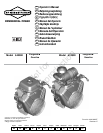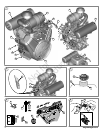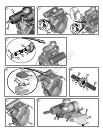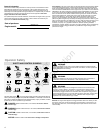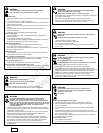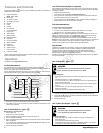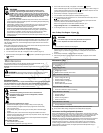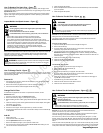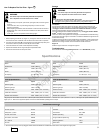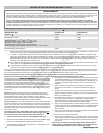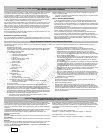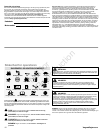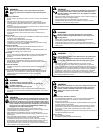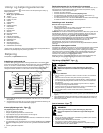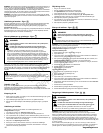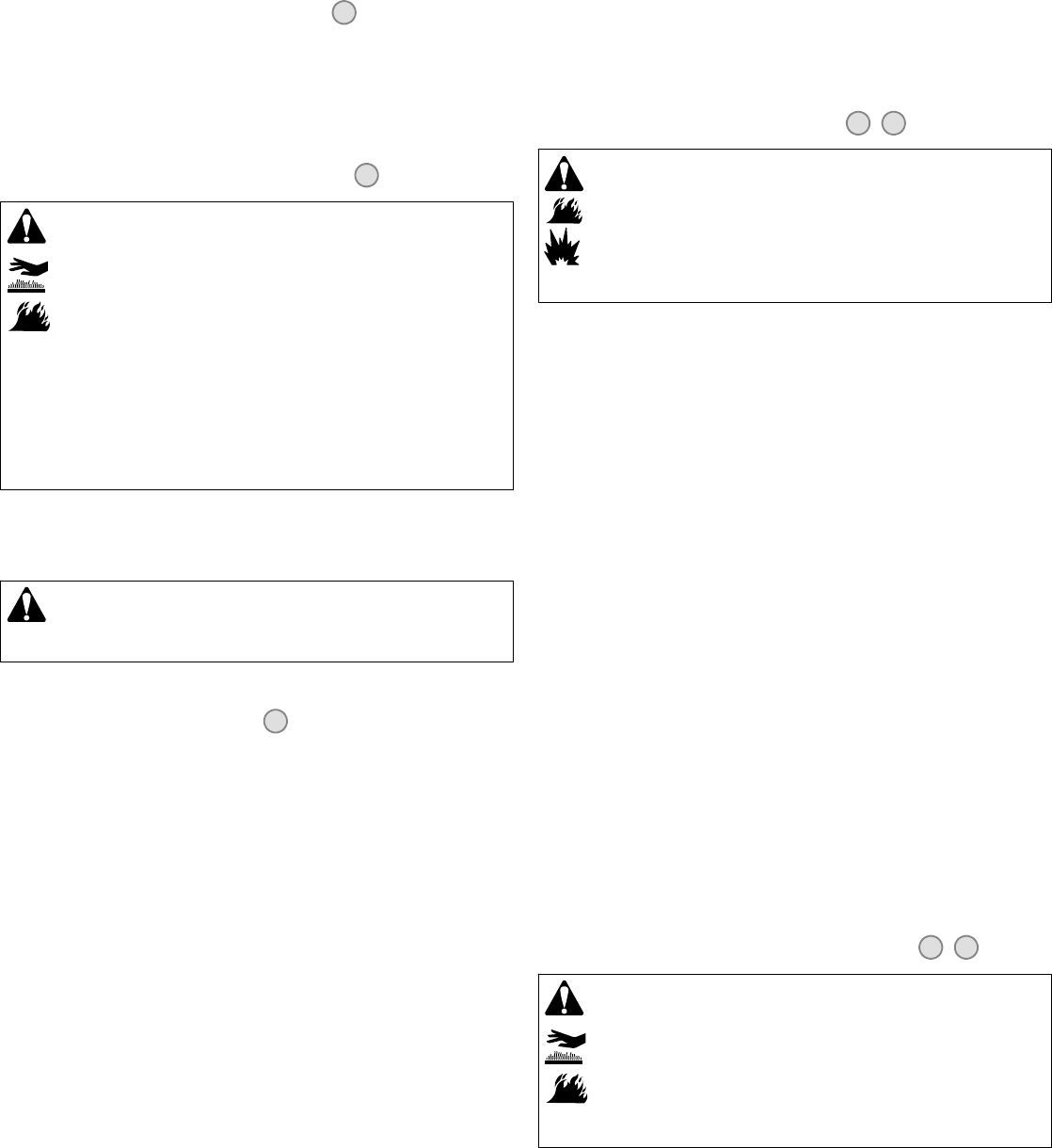
8
VanguardEngines.com
How To Replace The Spark Plug - Figure
5
Check the gap (A, Figure 5) with a wire gauge (B). If necessary, reset the gap. Install
and tightenthe sparkplug to the recommendedtorque. For gapsetting ortorque, seethe
Specifications section.
Note: In some areas, local law requires using a resistor spark plug to suppress ignition
signals. If this engine was originally equipped with a resistor spark plug, use the same
type for replacement.
Inspect Muffler And Spark Arrester - Figure
6
Running engines produce heat. Engine parts, especially muffler,
become extremely hot.
Severe thermal burns can occur on contact.
Combustible debris, such as leaves, grass, brush, etc. can catch fire.
WARNING
Allow muffler, engine cylinder and fins to cool before touching.
Remove accumulated debris from muffler area and cylinder area.
It is a violation of California Public Resource Code, Section 4442, to useor
operate the engine onany forest-covered, brush-covered, or grass-covered land
unless the exhaust system is equipped with a spark arrester, as defined in
Section 4442, maintained in effective working order. Other states or federal
jurisdictions may have similar laws. Contact the original equipment
manufacturer, retailer, or dealer to obtaina spark arrester designed for the
exhaust system installed on this engine.
Remove accumulated debris from muffler area and cylinder area.Inspect the muffler (A,
Figure 6) for cracks, corrosion, or other damage. Remove the spark arrester (B), if
equipped, and inspect for damage or carbon blockage. If damage is found, install
replacement parts before operating.
WARNING: Replacement parts must be of the same design andinstalled
in the same position as the original parts. Other parts may not perform aswell, may
damage the unit, and may result in injury.
How To Change The Oil - Figure
7
Used oil is a hazardous waste product and must be disposed of properly. Do not discard
with householdwaste. Check with your localauthorities, service center, or dealer forsafe
disposal/recycling facilities.
Remove Oil
1. With engine off but still warm, disconnect the spark plug wire (A) and keep it away
from the spark plug (Figure 7).
2. Remove the oil drain plug (B). Drain the oil into an approved container.
3. After the oil has drained, install and tighten the oil drain plug.
Change The Oil Filter
All models are equipped with an oil filter. For replacement intervals, see the
Maintenance chart.
1. Drain the oil from the engine. See Remove Oil section.
2. Remove the oil filter (C, Figure 7) and dispose of properly.
3. Before installing the new oilfilter, lightly lubricate the oil filter gasket with fresh, clean
oil.
4. Install the oil filter by hand until the gasket contacts the oil filter adapter, then tighten
theoilfilter1/2to3/4turns.
5. Add oil. See Add Oil section.
6. Start and run the engine. As the engine warms up, check for oil leaks.
7. Stop the engine and check the oil level. It should be at the top of the full indicator (F)
on the dipstick.
Add Oil
Place engine level.
Clean the oil fill area of any debris.
See the Specifications section for oil capacity.
1. Remove the dipstick (D, Figure 7) and wipe with a clean cloth.
2. Pour the oil slowly into the engine oil fill (E). Do not overfill. After adding oil, wait
one minute and then check the oil level.
3. Install and tighten the dipstick.
4. Remove thedipstick andcheck the oillevel. Itshouldbe at the top of the fullindicator
(F) on the dipstick.
5. Install and tighten the dipstick.
How To Service The Air Filter - Figure
8 9
WARNING
Fuel and its vapors are extremely flammable and explosive.
Fire or explosion can cause severe burns or death.
Never start or run the engine with the air cleaner assembly (if equipped) or the
air filter (if equipped) removed.
NOTICE: Do not use pressurized air or solvents to clean the filter. Pressurized air can
damage the filter and solvents will dissolve the filter.
The air filter system uses either acyclonic air filter or a low-profile air filter. See the
Maintenance Chart for service requirements.
Cyclonic Air Filter System
1. Open the latches (A) and remove the cover (B).SeeFigure8.
2. Remove the air filter (C).
3. To loosen debris, gently tap the air filter on a hard surface. If the air filter is
excessively dirty, replace with a new air filter.
4. The cyclonic air filter system also has a safety filter (D) (if equipped). See the
Maintenance Chart for service requirements. To remove, carefully pull the safety
filter away from aircleaner body (E) and discard. Make sure that dirt ordebris do not
enter the engine.
5. Install the new safety filter in the air cleaner body.
6. Install the air filter over the safety filter.
7. Install the cover and close the latches.
Low-Profile Air Filter System
1. Remove the knob (F) and the cover (G).SeeFigure9.
2. Remove the nut (H) and the retainer (J).
3. Remove the air filter (K).
4. Remove the pre-cleaner (L), if equipped, from the air filter.
5. To loosen debris, gently tap the air filter on a hard surface. If the air filter is
excessively dirty, replace with a new air filter.
6. Wash the pre-cleaner in liquid detergent and water. Then allow it to thoroughly air
dry. Do not oil the pre-cleaner.
7. Assemble the dry pre-cleaner to the air filter.
8. Install the air filter and secure with retainer and nut.
9. Install the cover and secure with knob.
How To Clean The Air Cooling System - Figure
11 12
Running engines produce heat. Engine parts, especially muffler,
become extremely hot.
Severe thermal burns can occur on contact.
Combustible debris, such as leaves, grass, brush, etc. can catch fire.
WARNING
Allow muffler, engine cylinder and fins to cool before touching.
Remove accumulated debris from muffler area and cylinder area.
NOTICE: Do not use water to clean the engine. Water could contaminate the fuel
system. Use a brush or dry cloth to clean the engine.
This is an air cooled engine. Dirt or debris can restrict air flow and cause the engine to
overheat, resulting in poor performance and reduced engine life.
Use a brush or dry cloth to remove debris fromthe finger guard (A, Figure 11). Keep
linkage, springs andcontrols (B) clean. Keep thearea around and behind themuffler (C)
free of any combustible debris. Make sure that the oil cooler fins (D) are free of dirt and
debris.
Clean the area under the panel (E, Figure 12). Loosen the two screws (F) until you hear
a click.Remove the paneland clean thearea of dirt and debris.Make sure theunderside
of the panel is also clean. Install the panel and tightenthe screws until you hear a click.
Not for
Reproduction



